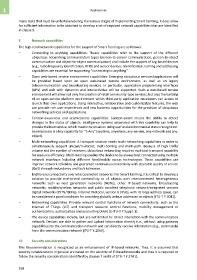Page 568 - 5G Basics - Core Network Aspects
P. 568
1 Applications
many tasks that must be undertaken during the various stages of implementing Smart Farming, it does allow
for sufficient information to be obtained to develop a set of required network capabilities that are identified
in clause 9.
9 Network capabilities
The high-level network capabilities for the support of Smart Farming are as follows:
– Connecting to anything capabilities: Theses capabilities refer to the support of the different
ubiquitous networking communication types (person-to-person communication, person-to-object
communication and object-to-object communication) and include the support of tag-based devices
(e.g., radio frequency identification, RFID) and sensor devices. Identification, naming and addressing
capabilities are essential for supporting "connecting to anything".
– Open web-based service environment capabilities: Emerging ubiquitous services/applications will
be provided based upon an open web-based service environment, as well as on legacy
telecommunication and broadcasting services. In particular, application programming interfaces
(APIs) and web with dynamics and interactivities will be supported. Such a web-based service
environment will allow not only the creation of retail community-type services, but also the building
of an open service platform environment which third-party application developers can access to
launch their own applications. Using interactive, collaborative and customizable features, the web
can provide rich user experiences and new business opportunities for the provision of ubiquitous
networking services and applications.
– Context-awareness and seamlessness capabilities: Context-aware means the ability to detect
changes in the status of objects. Intelligence systems associated with this capability can help to
provide the best service, which meets the situation using user and environmental status recognition.
Seamlessness is a key capability for "5 Any" (anytime, anywhere, any-service, any-network and any-
object).
– Multi-networking capabilities: A transport stratum needs multi-networking capabilities in order to
simultaneously support unicast/multicast, multi-homing and multi-path. Because of high traffic
volume and the number of receivers, ubiquitous networking requires multicast transport capability
for resource efficiency. Multi-homing enables the device to be always best connected using multiple
network interfaces including different fixed/mobile access technologies. These capabilities can
improve network reliability and guarantee continuous connectivity with desirable quality of service
(QoS) through redundancy and fault tolerance.
– End-to-end connectivity over interconnected networks: For Smart Farming, it is critical to develop a
solution to provide end-to-end connectivity to all objects over interconnected heterogeneous
networks such as next generation networks (NGNs), other IP-based networks, broadcasting
networks, mobile/wireless networks and public switched telephone network/integrated services
digital networks (PSTN/ISDNs). Internet Protocol, version 6 (IPv6), with its large address space, can
be considered a good candidate for providing globally unique addresses to objects [ITU-T Y.3041].
– Networking capabilities: Provide relevant control functions of network connectivity, such as the
Internet of Things (IoT) and transport resource control functions, mobility management or
authentication, authorization and accounting (AAA) [b-ITU-T Y Suppl. 3].
– The device capabilities include, but are not limited to: Direct interaction with the communication
network: Devices are able to gather and upload information directly (i.e., without using gateway
capabilities) to the communication network and can directly receive information (e.g., commands)
from the communication network [ITU-T Y.2060].
10 Security considerations
This Recommendation is recognized as an enhancement of IP-based networks. Thus, it is assumed that
security considerations in general are based on the security of IP-based networks and thus it is required to
follow the security considerations identified by clauses 7 and 8 of [ITU-T Y.2701].
558

